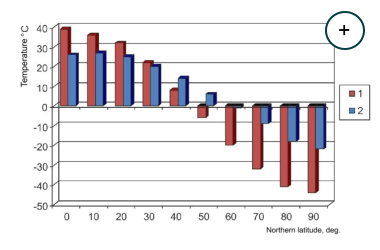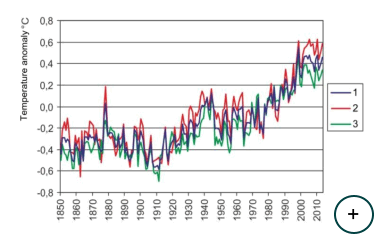| |
SOLAR RADIATION AND CLIMATE
OF THE EARTH |
|
This section of the geophysical survey presents geophysical data that reflects results of the latest studies related to the problems associated with the natural environment, the Earth’s biosphere and the effects of global climate change (as the most important characteristics of the natural environment), in connection with long-term variations of solar radiation effecting certain environments, as defined terrestrially by mechanical processes. The study encompasses the reaction of certain components of the natural environment, including: the atmosphere, the World’s oceans, the cryosphere and biosphere, as well as climatic characteristics of the natural environment to an external stimuli – variability of arriving solar radiation.
In the graphs below you can see prognostic scenarios, calculated on the basis of regression equations, of changes in near-surface temperature of the Earth, the World’s ocean’s average surface temperature, the measurement of sea surface ice, the duration of zonal and meridional circulation and other related geophysical information. The temperature fluctuations of the Earth’s atmosphere and ocean’s is a key element of climate study (along with atmospheric precipitation and circulation processes in the atmosphere and ocean’s). Temperature fluctuations of the Earth are due to the result of solar radiation, which transforms into heat emission during insolation of the Earth’s surface. Within the biosphere of the Earth, the variations of temperature fluctuations caused by solar radiation effect the variations and conditions of heat exchange intensity in the atmosphere and ocean’s, the variations in thickness of the sea surface ice, the development and degradation of ice, permafrost in the Earth’s cryosphere, variations in the fertility of different cultures, the succession of vegetation areas and other related environmental conditions.
Atmospheric conditions are part of a complicated dynamic system for which, two of the most important functions may be characterized by known simplification. The first, and most well known condition, is the greenhouse effect or heat retention. When letting in solar short-wave radiation the Earth’s atmosphere retains long-wave radiation, emitted from the Earth’s surface. This function depends, firstly, on the Earth’s atmosphere composition (density). Quantitatively, the value of the greenhouse effect is determined as the difference between the effective temperature of the Earth (calculated from the Stefan-Boltzman law equation and equals to 249Ę or -24 °Ń) and the average near surface temperature of the Earth (approximately 14 °Ń). In case of unvaried flow of solar radiation, the average near surface temperature is determined by the heat balance of the Earth, for which there are sufficient equal conditions in short wave solar radiation absorption quantity (measured via the Earth’s surface, atmosphere and ocean’s) and emission of long wave radiation. Since solar radiation flow varies over time, the characteristics of heat balance, as well as values of average surface temperature, correspond accordingly.
The second most important function of the atmosphere is heat exchange or redistribution of heat (this function is also directly related to the World’s ocean’s). As mentioned previously, solar radiation arriving to the Earth’s surface is transformed into heat energy, which is then redistributed into the Earth’s atmosphere (and into the ocean’s) in the direction from the equatorial area (source of heat) to the polar areas (heat sink). This redistribution results in smoothing of latitudinal temperature variations in the meridional direction (Monin, Shishkov, 1979). This heat exchange mechanism is also known as the “first thermal mechanism” (Shuleykin, 1953). Over it’s annual course, it most intensively appears in the hemispheres winter semester due to the significant values of inter-latitude temperature gradient. There are also other heat exchange mechanisms, these include: heat exchange between continents and oceans connected with seasonal change in areas of heat sources and sinks (the “second thermal mechanism”, Shuleykin, 1953), heat exchange between ocean and atmosphere (Anisimov and others, 2011), seasonal heat exchange between hemispheres (Shaw, 1936; Stekhnovsky, 1960; Sidorenkov, Stekhnovsky, 1971, 1972; Sidorenkov, 2002). The redistribution of heat in the atmosphere takes place in the process of movement of air masses (circulation processes in the atmosphere), as well as in the ocean – water masses. In addition, as it is well known in physics, heat exchange appears in the form of heat conduction, convection and emission. Presentation of inter-latitude heat exchange in the Earth’s atmosphere is shown in Table 1 and in Fig.1. The higher the temperature contrasts between equatorial and polar areas, the more intensive the rotational motion in the troposphere. The latter contributes to some leveling off of temperature contrast by transfer of excessive heat to higher latitudes and excessive cold to lower latitudes. The significance of this mechanism in forming the temperature field and, consequently, air circulation, may be observed by data provided in Table 1. The displayed data shows that interlatitude air exchange results in a temperature drop of 7-13 °Ń in low latitudes and in a temperature rise of 19-23 °Ń in high latitudes, and provides evidence that during inter-latitude heat-exchange, areas in high latitudes gain additional warmth, and in low latitudes become cooler due to inflow of cold air from higher latitudes (Drozdov and others, 1989). The average value of temperatures of the Earth’s hemispheres resulting from inter-latitude heat exchange barely fluctuates. Only redistribution of heat obtained from solar radiation takes place over the Earth’s surface. The average near surface temperature of the Northern hemisphere, calculated based on data for conditions of radiation equilibrium (Table 1), is 14.2 °Ń, calculated based on actual data is 15.3 °Ń. In his work Ě. Milankovich (Milankovich, 1939) provides average annual temperatures values for individual parallels (for static atmosphere and uniform distribution of land with uniform Earth surface). This data corresponds to the average temperature of the hemisphere equal to 15.1 °Ń. Taking into account possible inaccuracies of the given values of average hemisphere temperature, it may be considered almost constant taking into consideration the invariable value of arriving solar radiation (within 14 -15 °C). The correlating time period is marked with the rise of average near surface temperature of the Earth’s hemispheres – warming of global climate (Fig. 2). The distribution of average values for latitude zones for near surface temperatures during the period from 1961 to 1990 are provided in Table 2. The given values correspond to average values of the near surface temperature of the Earth as approximately 13.97 °Ń, Northern hemisphere – 14.59 °Ń, Southern hemisphere – 13.36 °Ń. Anomaly values distribution, provided in Fig. 2, are calculated in relation to these average values. One of the main objectives of our research is to determine the primary reasons for the rise in average near surface temperature of the Earth and the surface layer of the World Ocean. It seems natural that the physical basis for the Earth’s global climate change explanation may be composed of fundamental physical correlations: gravity and electromagnetism. Within this framework, there have been various calculations conducted of values for solar radiation arriving to the Earth’s ellipsoid surface with the absence of atmospheric condition accountability for the Earth’s perturbative orbital motion over short time intervals. The results of these solar climate calculations and accompanying research are presented in the corresponding sections of the site in the form of a radiation database, as well as in text form (variations of the Earth solar climate).
The exploration for the reasons of global temperature shifts is connected with the study of inter latitude heat exchange reaction and greenhouse effect response (the most important functions of the atmosphere and ocean’s) to variations in arrival of solar radiation. These phenomena have been carefully studied based on analysis of the connections between long-term annual fluctuations in the near surface temperature of the Earth, the surface layer temperature of the ocean’s, the reduction of sea surface ice in the Northern hemisphere, the change in duration of zonal and meridional circulation and other climatic and biospheric changes with long term annual variations of arriving solar radiation and accumulated solar radiation. These results are specific for individual components of the natural environment, and the results of these studies are provided in corresponding sections of the site. The primary results and conclusions are presented in summarized form on certain pages of the site.
|
|||||||||||||||||||||||||||||||||||||||||||||||||||||||||
|
SOLAR RADIATION AND CLIMATE |
||
|
© www.solar-climate.com
|
|
|
||||||||||||||||||||||||||||||||||||||||||
|
|
|||







